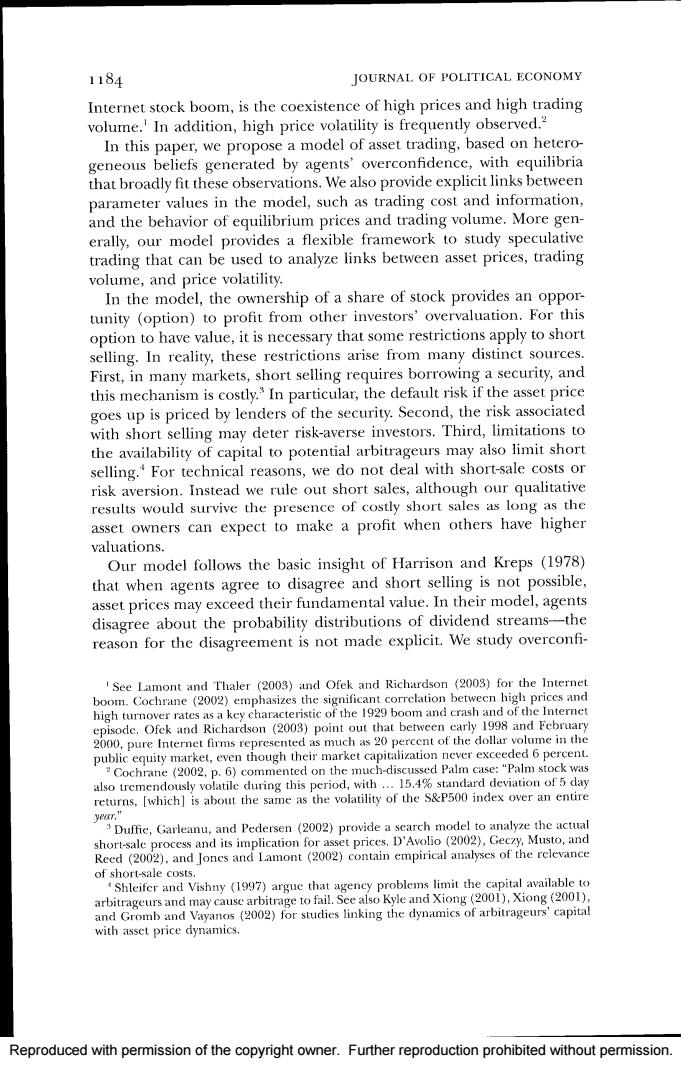正在加载图片...

1184 JOURNAL OF POLITICAL ECONOMY Internet stock boom,is the coexistence of high prices and high trading volume.'In addition,high price volatility is frequently observed.? In this paper,we propose a model of asset trading,based on hetero- geneous beliefs generated by agents'overconfidence,with equilibria that broadly fit these observations.We also provide explicit links between parameter values in the model,such as trading cost and information, and the behavior of equilibrium prices and trading volume.More gen- erally,our model provides a flexible framework to study speculative trading that can be used to analyze links between asset prices,trading volume,and price volatility. In the model,the ownership of a share of stock provides an oppor- tunity (option)to profit from other investors'overvaluation.For this option to have value,it is necessary that some restrictions apply to short selling.In reality,these restrictions arise from many distinct sources. First,in many markets,short selling requires borrowing a security,and this mechanism is costly.In particular,the default risk if the asset price goes up is priced by lenders of the security.Second,the risk associated with short selling may deter risk-averse investors.Third,limitations to the availability of capital to potential arbitrageurs may also limit short selling.For technical reasons,we do not deal with short-sale costs or risk aversion.Instead we rule out short sales,although our qualitative results would survive the presence of costly short sales as long as the asset owners can expect to make a profit when others have higher valuations. Our model follows the basic insight of Harrison and Kreps (1978) that when agents agree to disagree and short selling is not possible, asset prices may exceed their fundamental value.In their model,agents disagree about the probability distributions of dividend streams-the reason for the disagreement is not made explicit.We study overconfi- 'See Lamont and Thaler (2003)and Ofek and Richardson (2003)for the Internet boom.Cochrane (2002)emphasizes the significant correlation betwecn high prices and high turnover rates as a key characteristic of the 1929 boom and crash and of the Internet episode.Ofek and Richardson(2003)point out that between early 1998 and February 2000,pure Internet firms represented as much as 20 percent of the dollar volume in the public equity market,even though their market capitalization never exceeded 6 percent. 2 Cochrane (2002,p.6)commented on the much-discussed Palm case:"Palm stock was also tremendously volatile during this period,with...15.4%standard deviation of 5 day returns,[which]is about the same as the volatility of the S&P500 index over an entire year." Duffic,Garleanu,and Pedersen (2002)provide a search model to analyze the actual short-sale process and its implication for asset prices.D'Avolio (2002),Geczy,Musto,and Reed (2002),and Jones and Lamont (2002)contain empirical analyses of the rclevance of short-sale costs. Shleifer and Vishny (1997)arguc that agency problems limit the capital available to arbitrageurs and may cause arbitrage to fail.See also Kyle and Xiong (2001),Xiong (2001), and Gromb and Vayanos (2002)for studies linking the dynamics of arbitrageurs'capital with asset price dynamics. Reproduced with permission of the copyright owner.Further reproduction prohibited without permission.Reproduced with permission of the copyright owner. Further reproduction prohibited without permission